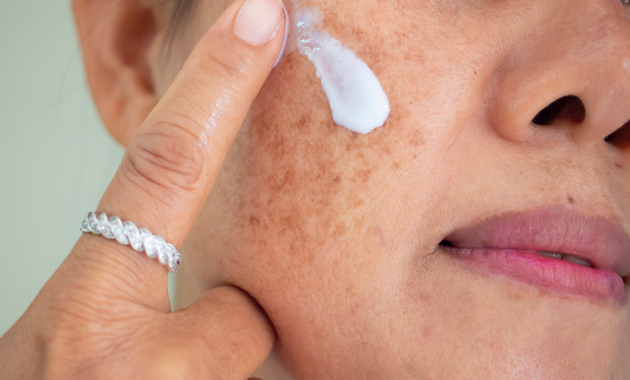
Are you dealing with patches of skin discoloration on your face that are not fading with time? It could be melasma. Melasma can appear on the skin at any point in time, and your day-to-day skin care routine may not be enough to combat its appearance. Melasma is a common skin problem in which brown to gray-brown patches appear, usually on the face that can last for years.
Melasma has been associated with female hormones. It is sometimes commonly referred to as “the mask of pregnancy,” because it is triggered by an increase in hormones in pregnant women. Melasma is a common skin disorder in the following groups of people:
-Women using birth control pills
-Pregnant women
-Menopausal women using hormone replacement therapy
But remember, melasma can also affect women who are not pregnant. It can also occur in men. So, do not consider it as a condition that affects only women (especially pregnant women).
Can Melasma Be Treated?
Sometimes melasma can fade on its own. This usually happens when a trigger, such as a pregnancy or birth control pill, causes the melasma. It may also fade when a woman delivers her baby or stops taking birth control pills.
However, some people have melasma for years or even a lifetime. If the melasma does not go away or a woman wants to keep taking birth control pills, melasma treatments are available.
These options can be used on their own or in conjunction with each other, as recommended by your dermatologist. The most common treatments for melasma include the following:
1. Hydroquinone
This medicine is a common first treatment for melasma. Hydroquinone acts as a skin-lightening agent and works by blocking melanin production. This leads to a lightening of the dark patches on your skin. Hydroquinone is available in the form of cream, lotion, gel, or liquid. You can get some of these over the counter. These products contain less hydroquinone as compared to a product that your dermatologist can prescribe.
2. Tretinoin and corticosteroids
To enhance skin lightening, your dermatologist may prescribe a second medicine. This medicine may be tretinoin or a corticosteroid, which is applied to the skin to help speed your body’s natural cell turnover process. This may help dark patches clear more quickly than they would on their own. Sometimes a medicine contains three medicines (hydroquinone, tretinoin, and a corticosteroid) in one cream. This is often called a triple cream.
Fight skin pigmentation and patchy skin with skin lightening creams. Tap to know more.
3. Other topical medicines
Your dermatologist may prescribe other skin lightening agents such as azelaic acid or kojic acid to help lighten melasma. This is usually recommended if the other commonly used methods for melasma treatment fail to show any results. Also, it is important to consult your doctor before using any of the treatment options as it is highly dependent on the condition and its severity. In some cases, these topical medicines may not show desirable results. In such a case, other options such as surgery might be considered.
4. Surgery
If topical medicines are not providing relief from the melasma, there are certain surgical procedures such as chemical peel, microdermabrasion, dermabrasion, laser treatment, or a light-based procedure that can help you to get rid of the dark patches of melasma.
What YOU Can Do To Fight Melasma?
No matter what treatment is the best option for you, remember prevention is the key. Wear sunscreen every day and a wide-brimmed hat whenever you’re outside. There’s more you can do on your own to help your skin heal and prevent future damage.
In addition to reducing sun exposure, try these steps:
1. Set up a good cleansing routine as pollutants can damage your skin and make it more susceptible to sun damage.
2. De-stress your skin with antioxidants such as Vitamins C and E which can help heal damage from sunlight.
3. Moisturize your skin regularly to restore the protective lipid layer.
Healthy Skin Matters..!! Choose from a great range of skincare products. Click Here!
4. Be diligent. Melasma will be quick to return if you’re not careful about sun protection. So, long-term maintenance requires an ongoing commitment to protecting your skin.
Melasma can be stubborn, though. Be patient during treatment. It often takes months before results are seen. And once your melasma clears, your doctor might recommend maintenance therapy to prevent it from returning.
(The article is reviewed by Dr. Swati Mishra, Medical Editor)
Disclaimer: The information produced in this article in the form of text, tips, suggestions, and products, comprise general advice for consumers. This is a sponsored article and 1mg does not promote or endorse any products or services.
References:
1. Unmasking the causes and treatments of melasma. Harvard Health Publishing https://www.health.harvard.edu/womens-health/unmasking-the-causes-and-treatments-of-melasma
2. Handel A, Miot L, Miot H. Melasma: a clinical and epidemiological review. Anais Brasileiros de Dermatologia. 2014;89(5):771-782. https://www.ncbi.nlm.nih.gov/pmc/articles/PMC4155956/
3. Melasma: Diagnosis and Treatment. American Academy of Dermatology Association(AAD)
https://www.aad.org/public/diseases/a-z/melasma-treatment
4. Bandyopadhyay D. Topical treatment of melasma. Indian Journal of Dermatology. 2009;54(4):303. https://www.ncbi.nlm.nih.gov/pmc/articles/PMC2807702/